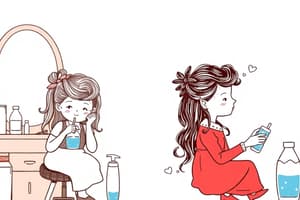Podcast
Questions and Answers
What are the risks of not having MSDS's available?
What are the risks of not having MSDS's available?
- Compliance with regulations
- Reliance on verbal warnings
- No effect on health
- Increased health risks (correct)
What do tuberculocidal disinfectants require?
What do tuberculocidal disinfectants require?
- No special care
- Only general cleaning
- Regular disposal
- Special methods of disposal (correct)
What was traced as the source of the infection in a salon?
What was traced as the source of the infection in a salon?
Mycobacterium fortuitum
It is essential to follow the laws and rules of your state at all times.
It is essential to follow the laws and rules of your state at all times.
Salon professionals are NOT allowed to treat what?
Salon professionals are NOT allowed to treat what?
Infectious diseases can only be spread from one person to another.
Infectious diseases can only be spread from one person to another.
What are one-celled organisms with both plant and animal characteristics known as?
What are one-celled organisms with both plant and animal characteristics known as?
Cocci are __________ shaped bacteria.
Cocci are __________ shaped bacteria.
What does the presence of pus indicate?
What does the presence of pus indicate?
Contagious diseases spread from one person to another.
Contagious diseases spread from one person to another.
What is the primary way direct transmission occurs?
What is the primary way direct transmission occurs?
What does indirect transmission involve?
What does indirect transmission involve?
What are organisms of microscopic to submicroscopic size called?
What are organisms of microscopic to submicroscopic size called?
What do toxins refer to?
What do toxins refer to?
An allergy is a reaction due to extreme sensitivity to certain __________.
An allergy is a reaction due to extreme sensitivity to certain __________.
What does decontamination involve?
What does decontamination involve?
What is the definition of disease?
What is the definition of disease?
Occupational diseases result from __________ associated with employment.
Occupational diseases result from __________ associated with employment.
What should be done during an exposure incident?
What should be done during an exposure incident?
What operation should be followed when salon implements contact blood?
What operation should be followed when salon implements contact blood?
How often should foot spas be disinfected?
How often should foot spas be disinfected?
You should use too much bleach for disinfection.
You should use too much bleach for disinfection.
What should you NEVER let come in contact with your skin?
What should you NEVER let come in contact with your skin?
What is the role of antiseptics?
What is the role of antiseptics?
What are universal precautions?
What are universal precautions?
Flashcards are hidden until you start studying
Study Notes
MSDS and Regulation
- Availability of Material Safety Data Sheets (MSDS's) is essential for safety when handling hazardous materials, critical for legal compliance.
Disinfectants and Salon Safety
- Tuberculocidal disinfectants can damage salon tools and require specific disposal methods.
- Always wear gloves when handling cleaning products.
Infections in Salons
- Mycobacterium fortuitum infections were linked to whirlpool foot spas in salons.
- Salon professionals cannot diagnose or recommend treatments for infections or diseases.
Types of Diseases and Bacteria
- Infectious diseases arise from harmful organisms, not always contagious.
- Bacteria are one-celled organisms displaying both plant and animal characteristics.
- Pathogenic bacteria include Cocci, Staphylococci, Streptococci, Diplococci, Bacilli, Spirilla.
Bacteria Characteristics
- Cocci are spherical, while Streptococci cause strep throat and Diplococci can lead to pneumonia.
- Spirilla are responsible for sexually transmitted diseases like syphilis and Lyme disease.
Bacterial Growth
- Bacteria reproduce by binary fission, dividing once they reach maximum size.
Infection Response
- Presence of pus indicates a bacterial infection, often localized in lesions or abscesses.
- Contagious diseases spread easily between individuals, occurring through direct or indirect transmission.
Microorganisms and Contamination
- Microorganisms can be harmful, producing various toxins affecting human health.
- Contamination refers to infectious materials on surfaces; decontamination involves removing these materials.
Understanding Diseases
- Occupational diseases result from workplace exposures, while systemic diseases affect the entire body through the bloodstream.
- Fungal infections, like Tinea Pedis, are common on feet; severe infections generally originate from compromised systems.
Infection Control
- Sterilization is the most effective infection control method.
- Follow guidelines for cleaning tools, maintaining a logbook for safety records.
Disinfectants
- Use effective disinfectants such as Accelerated Hydrogen Peroxide (AHP), changing every two weeks.
- Avoid fumigants in salons; limit bleach use to prevent damage to surfaces.
Personal Protective Equipment
- Always handle disinfectants carefully, preventing skin contact with harmful substances.
Cleanliness Procedures
- Store clean, disinfected tools in covered containers.
- Regularly disinfect foot spas: run disinfectant for ten minutes, then rinse with clean warm water, followed by proper handling after each use.
Occupational Health Practices
- Universal Precautions require assuming all blood and body fluids are potentially infectious; include proper handwashing and safe handling of sharp objects.
Effective Cleaning Tips
- No additives or tablets can replace the need for manual cleaning and disinfecting.
- Antibacterial soaps may dry skin and are no more effective than regular soap.
Routine Cleanliness
- Maintain a schedule, disinfect tools and equipment weekly at a minimum, particularly foot spas, ensuring safe client interactions.
Studying That Suits You
Use AI to generate personalized quizzes and flashcards to suit your learning preferences.





